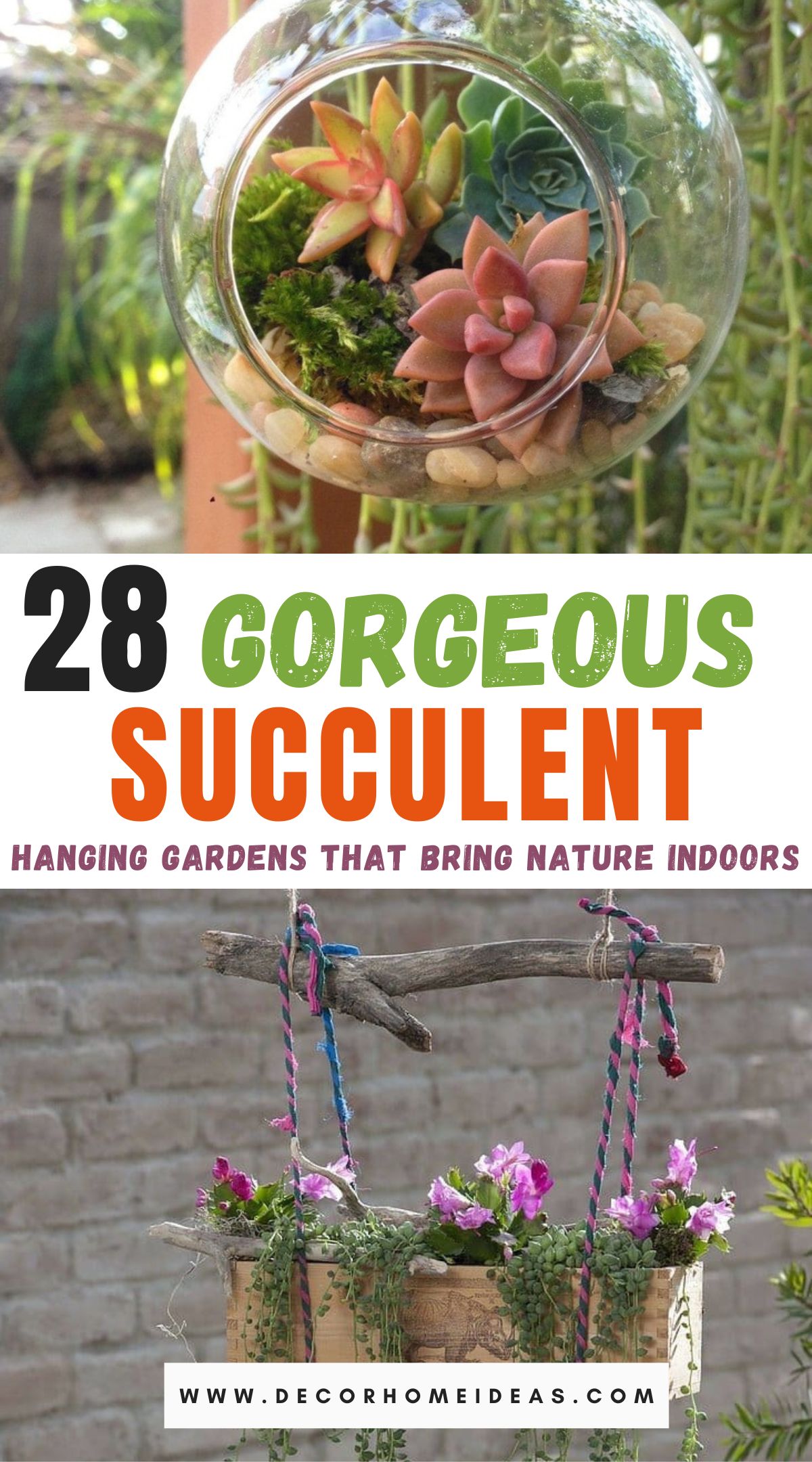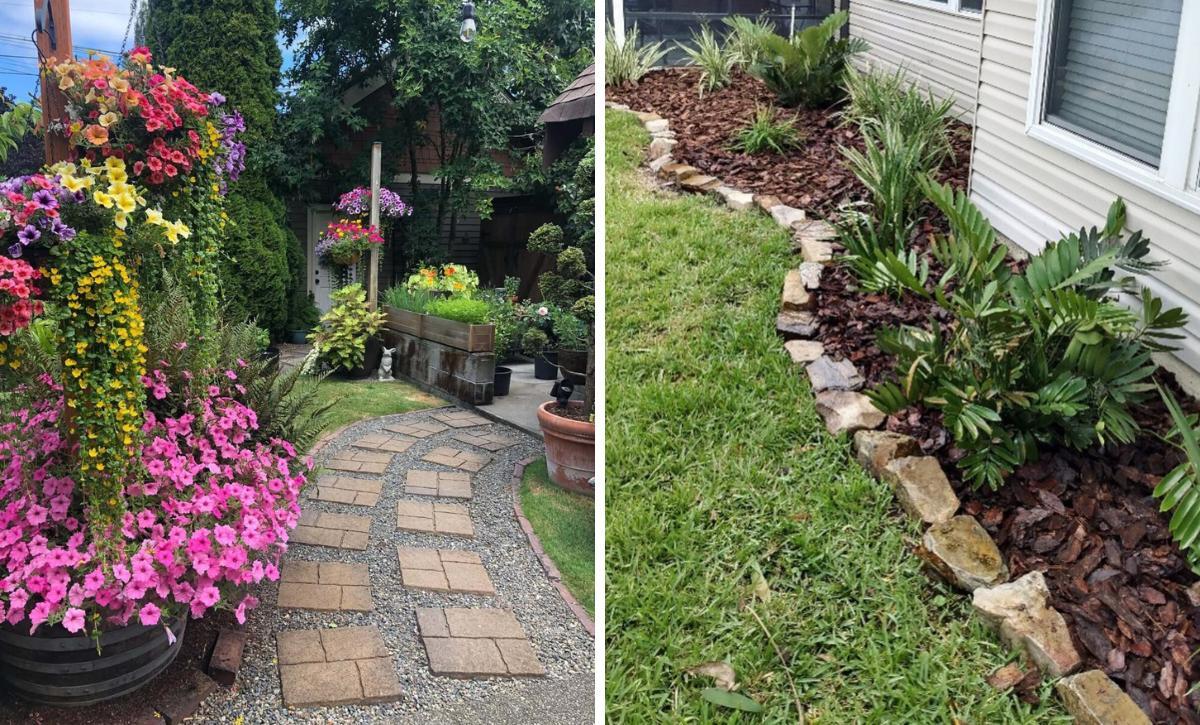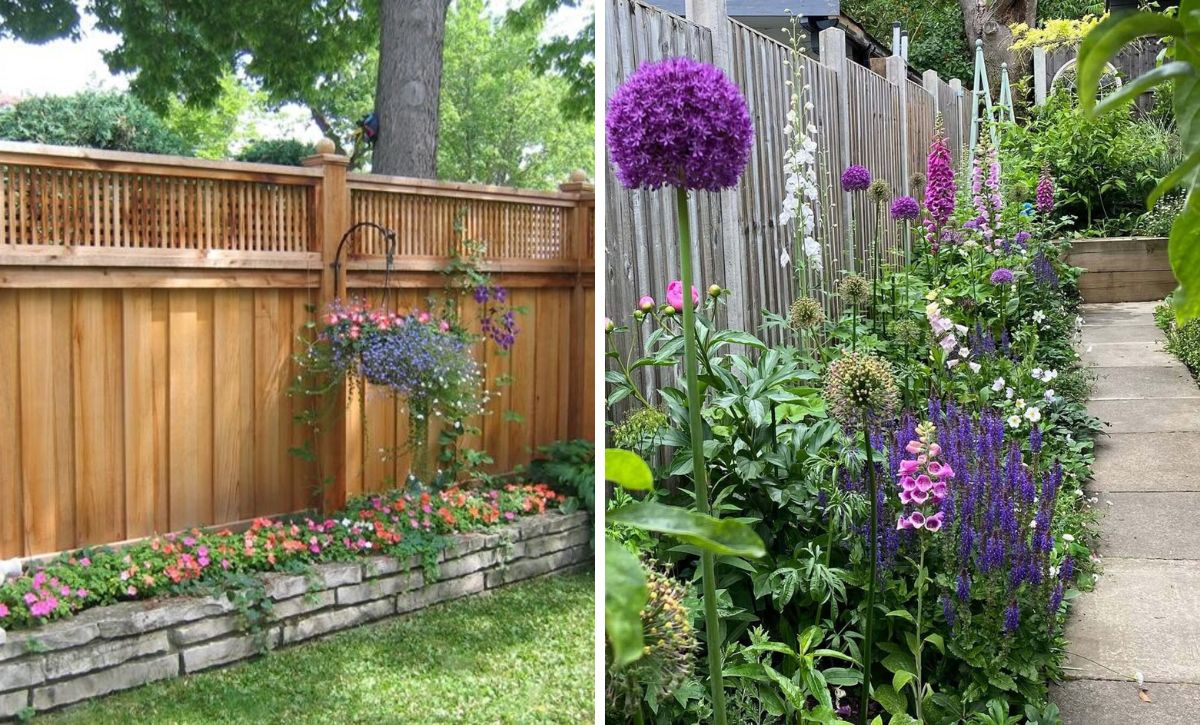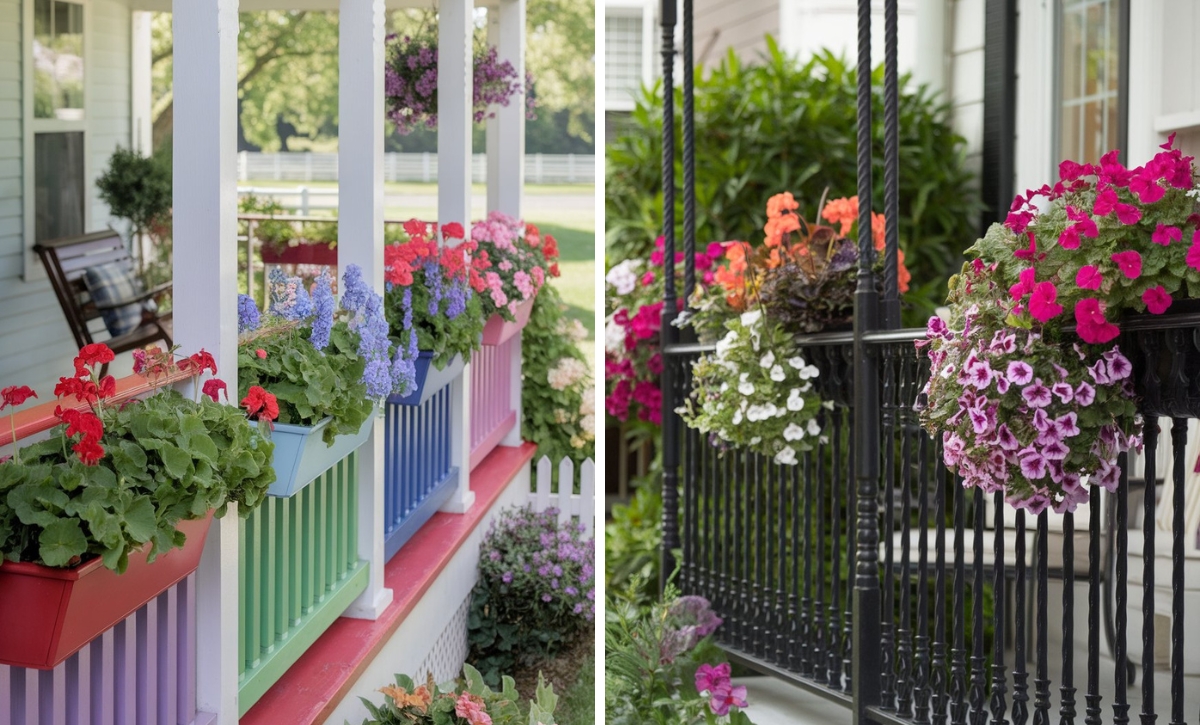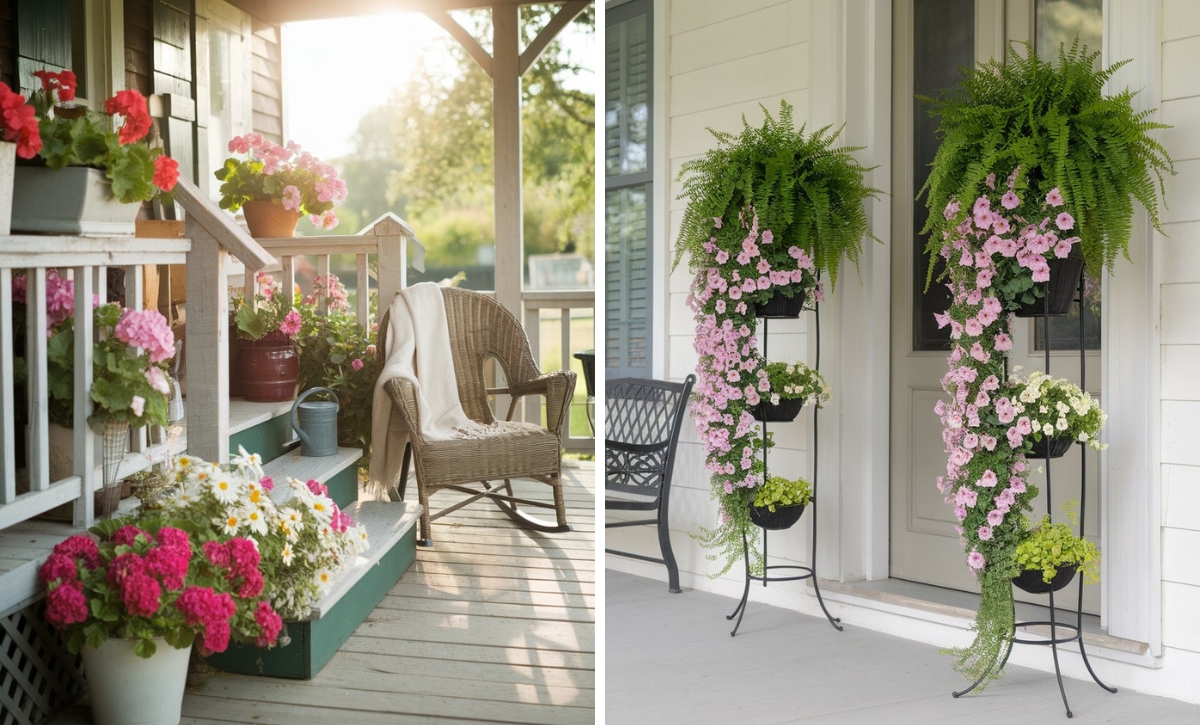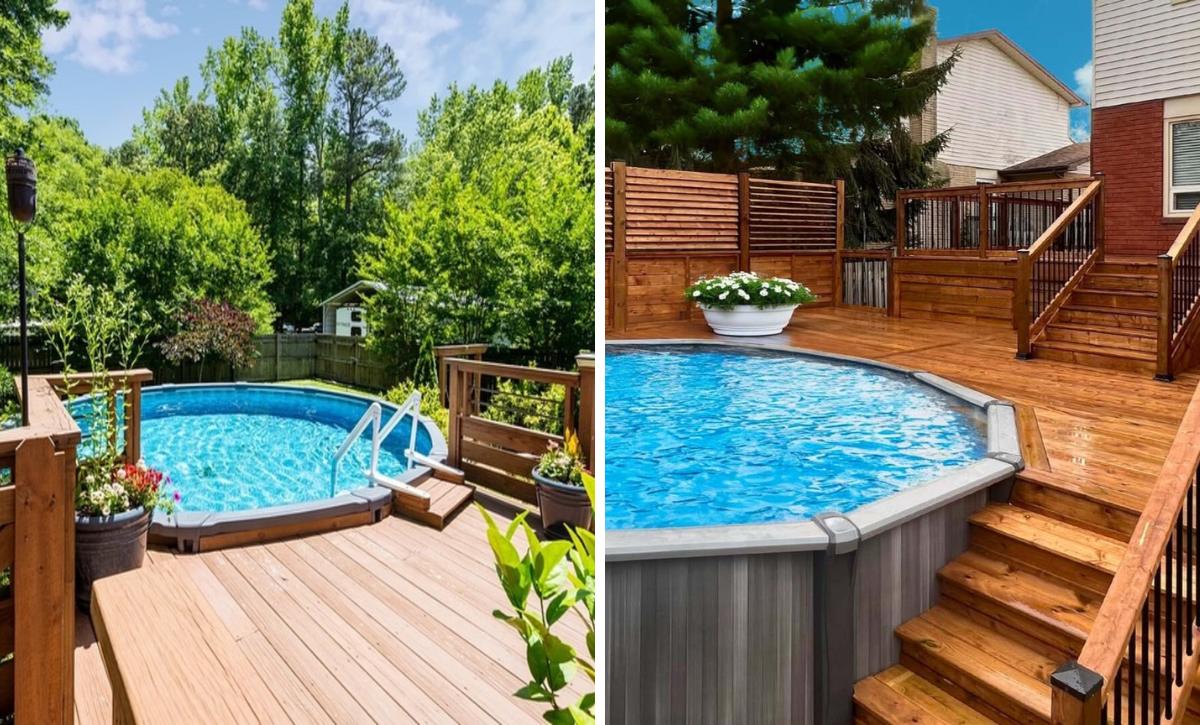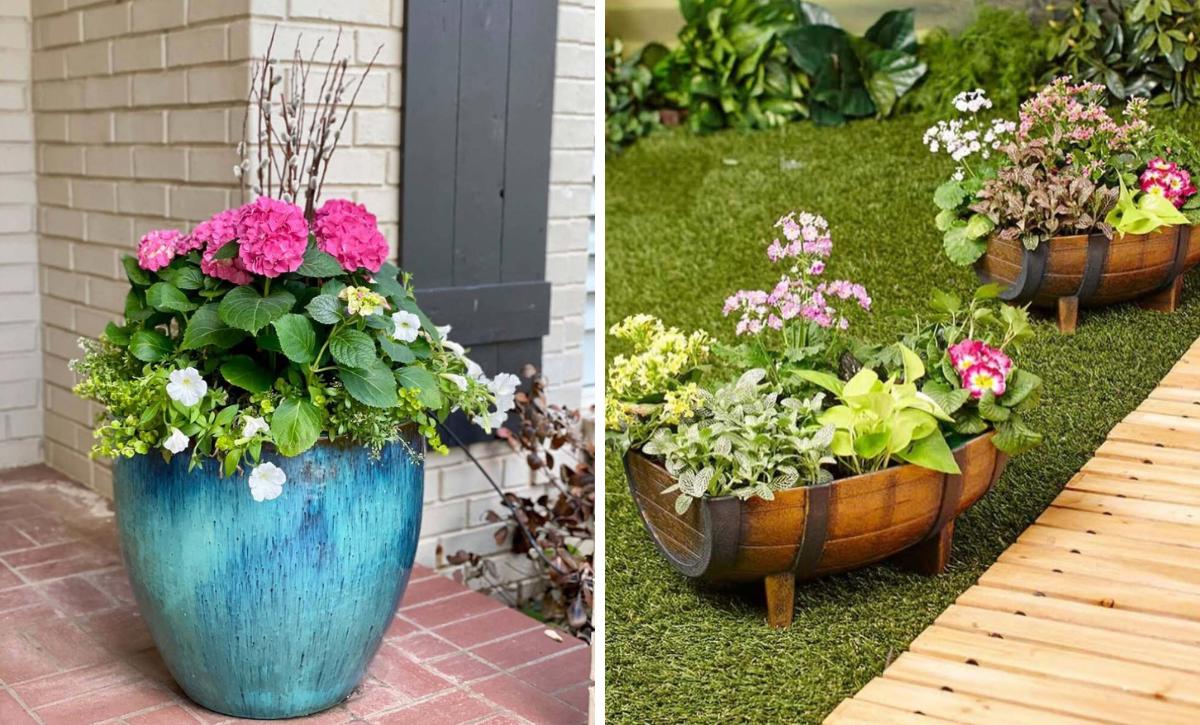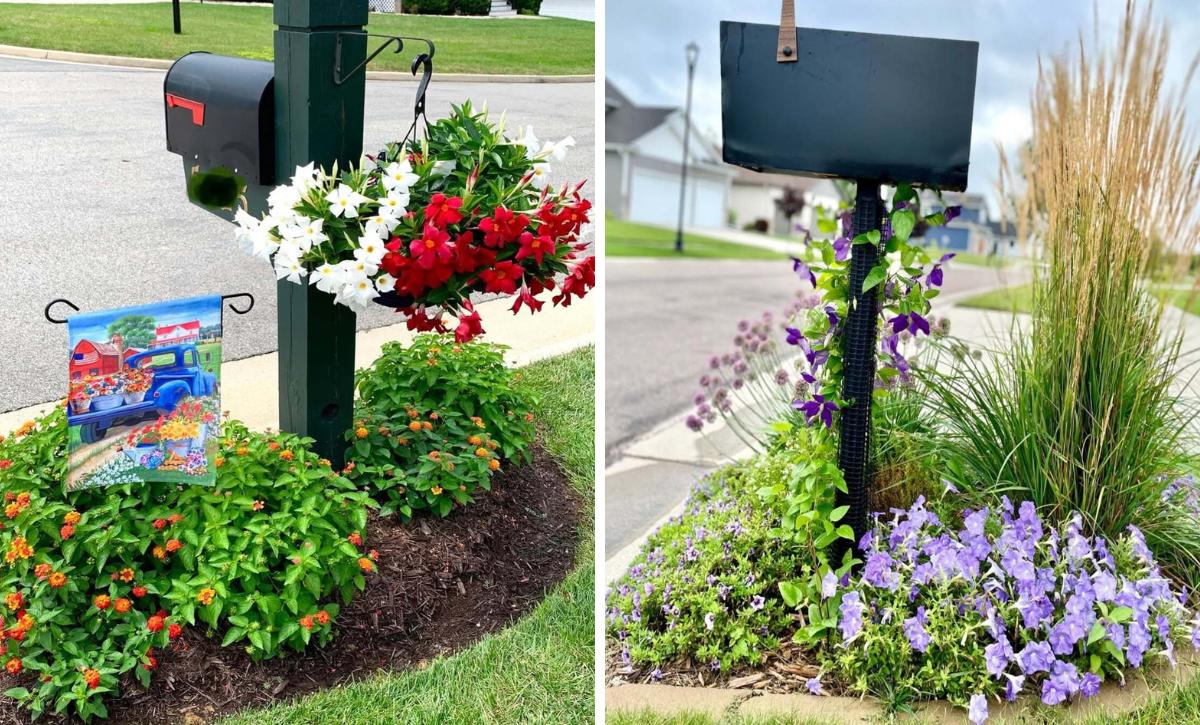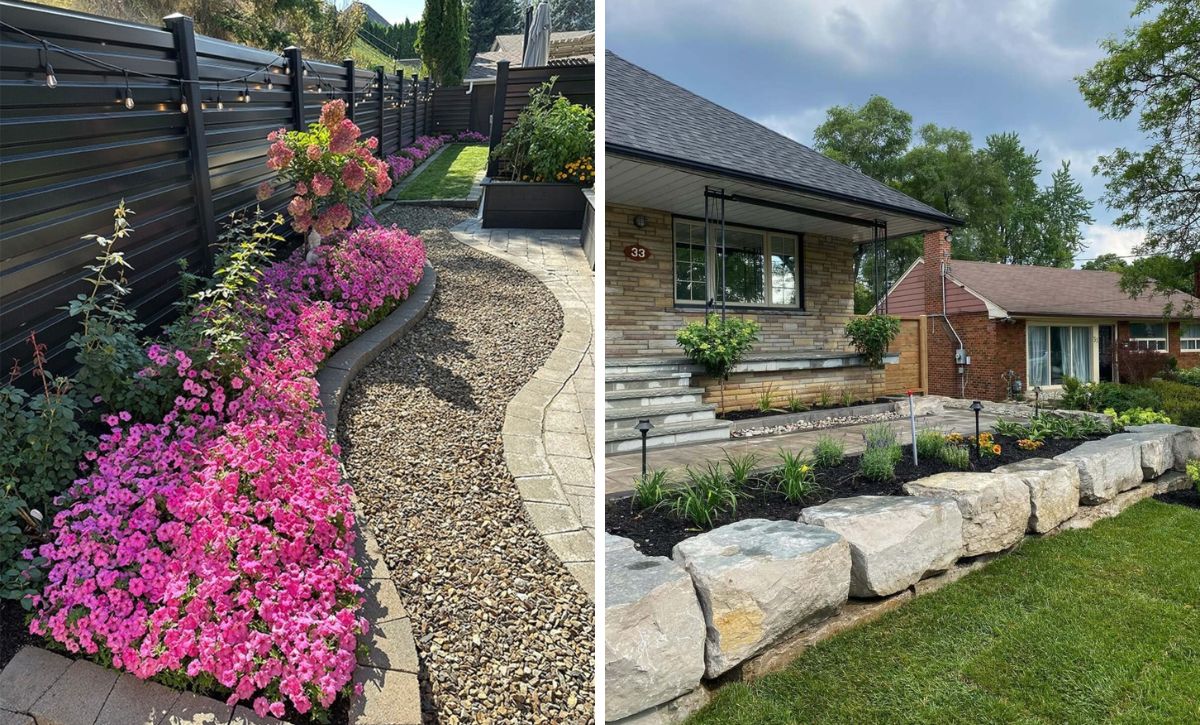Succulents are some of the most common houseplants. They’re easy to grow and care for and come in various dazzling shapes and colors. While they’re commonly grown as ground covers, succulents can also be an eye-catching addition when grown in hanging gardens.
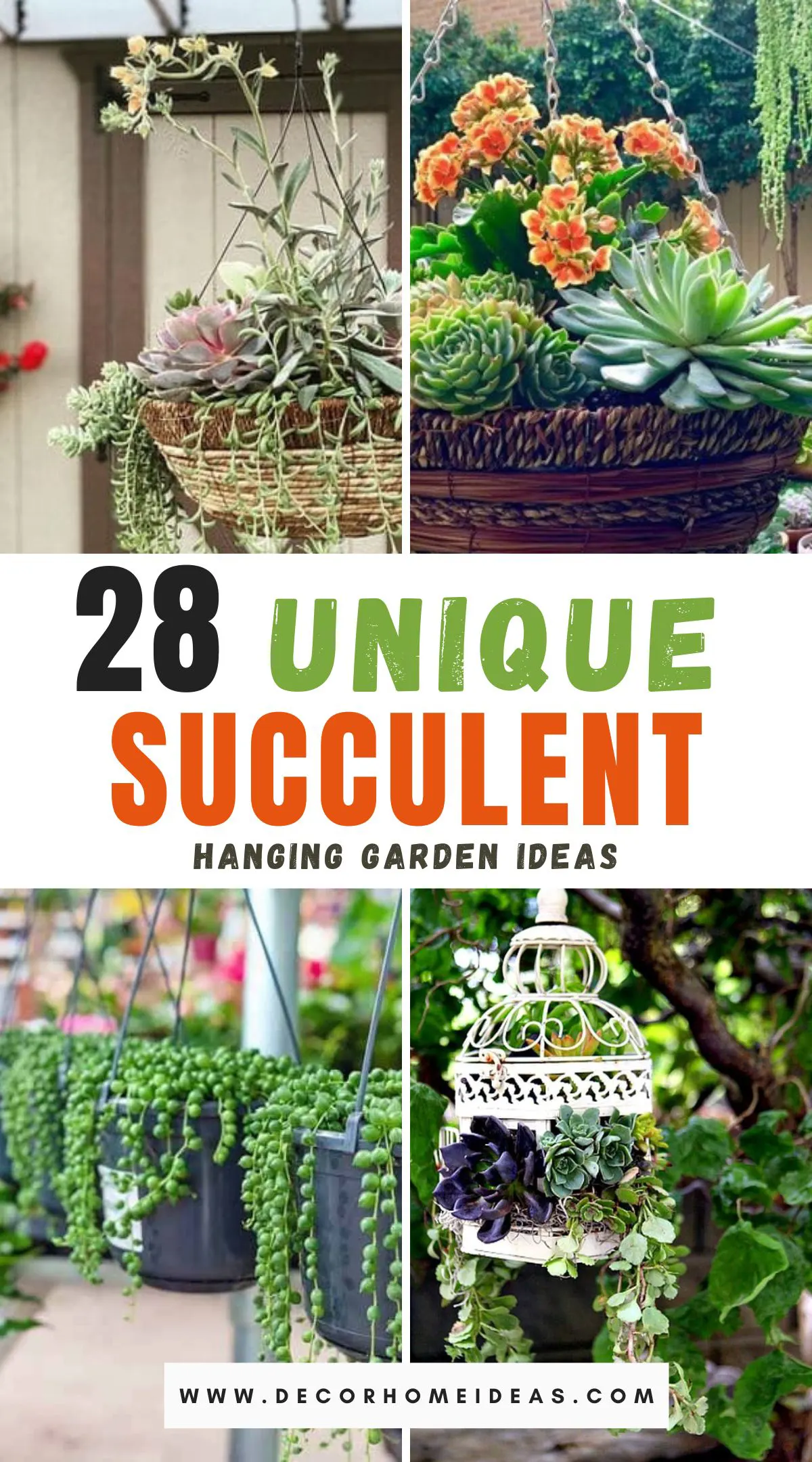
There are tons of ideas to explore with such a design, ranging from hanging baskets and planters to more creative designs like cages. Here are 28 succulent hanging gardens that you can use to spruce up your space.
Take a look!
1. Go for a Natural Woven Hanging Basket
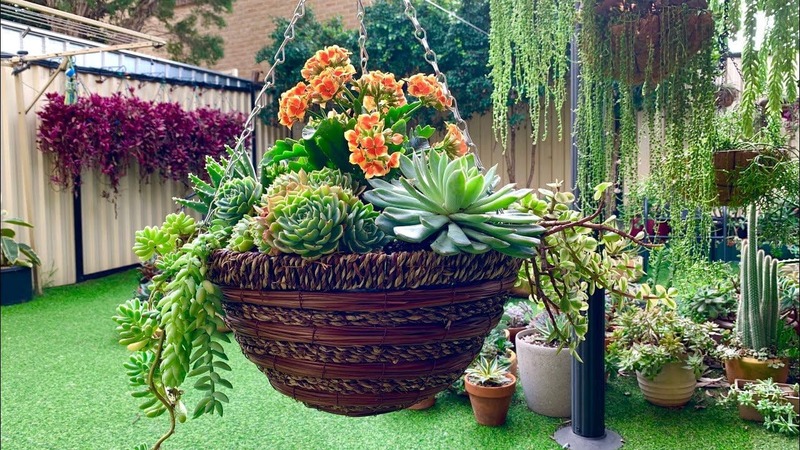
Gardening is one of the most sustainable decor options for your home, whether indoors or outdoors, and what better way to promote sustainable efforts than growing your succulents in a natural woven basket?
In this hanging basket design, a colorful woven basket is used as a planter to grow a variety of succulents. The basket’s porous nature allows for easy drainage, which is crucial for the plants.
2. Brightly Colored Suspended Bowl
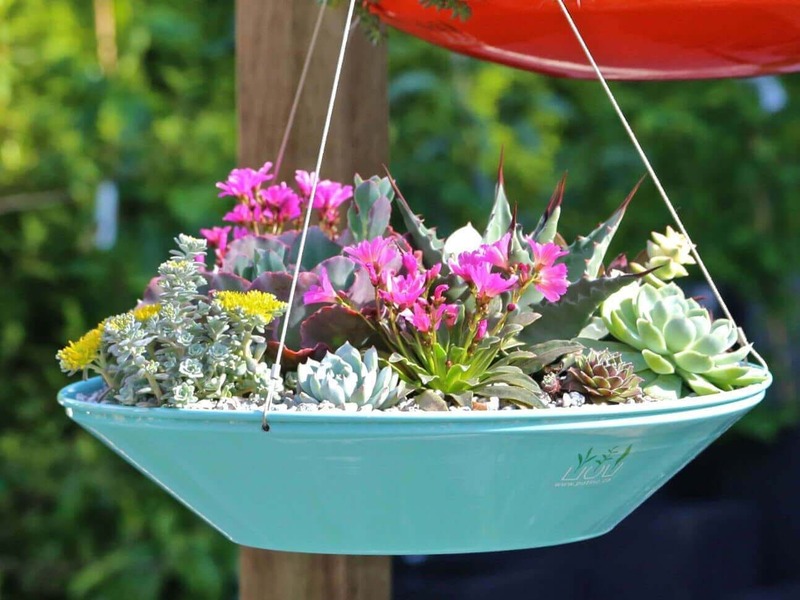
Succulents shouldn’t be the only thing adding visual interest to your space; you can also try a colorful bowl to add extra pizazz.
In this design, a beautiful turquoise bowl acts as the planter for these colorful succulents. The white pebble stones added to the potting soil make the design even more attractive.
3. Succulent Ball
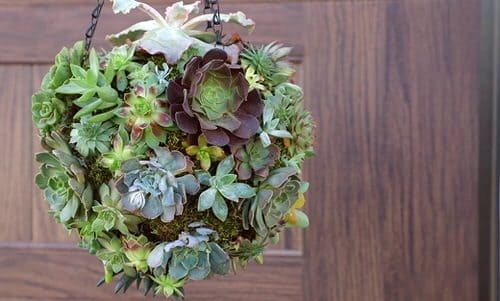
Looking for a unique, inconspicuous design? Why not try this suspended succulent round planter? Here, the planter is entirely covered by succulents, giving it a unique spherical shape resembling a ball.
You can create such a planter by making several holes and perforations in a spherical ball and planting succulents.
4. Go for Hanging Buckets
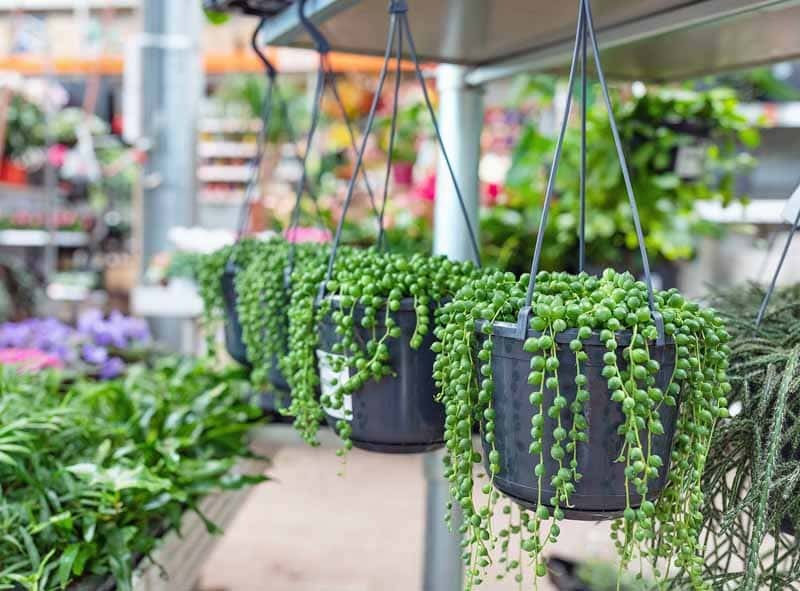
Sure, hanging baskets and planters are effective and easy to obtain, but hanging buckets are even more effective and probably cheaper. Add some drainage holes to a bucket, grow your succulents, and you’ll enjoy your plants in no time.
You can even repurpose old buckets as planters. Here, several matching buckets are used to grow this beautiful string of pearls succulent.
5. Showcase Your Love
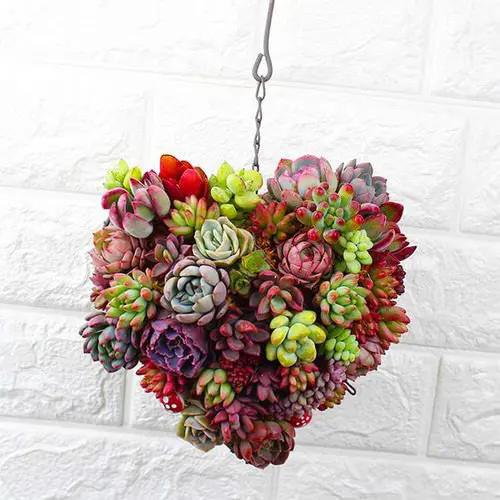
The multi-colored nature of succulents makes them easy to get creative with. The planter has been shaped like a heart, and several colored succulents have been added to the design.
The bright red colors of the succulents improve the design’s visual appeal and contribute to the overall theme of love and warmth.
6. Try a Wooden DIY Planter
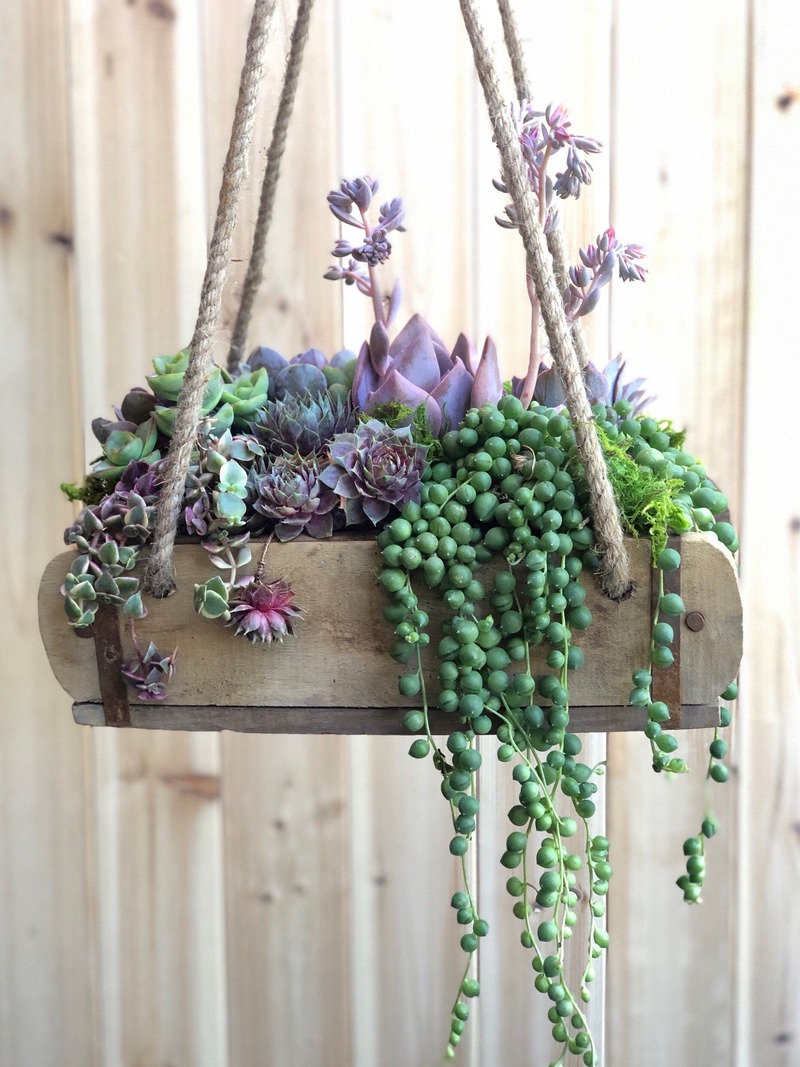
Repurposing old items you aren’t using is one of the best ways to clear clutter and manage waste sustainably. Besides, taking on a DIY project can be an excellent way to learn a new skill.
This planter has been fashioned from old timber logs, providing a wide surface area to grow a variety of plants. Try getting creative with your items rather than opting for new supplies.
7. Contrast with White Planters
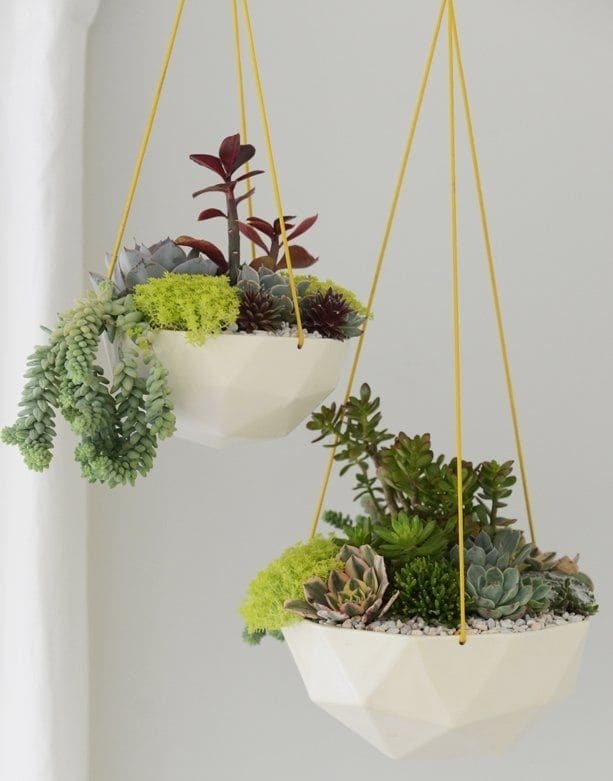
Contrasting is a proven method of improving visual interest both indoors and outdoors. By picking the right colors, you can use your planter and succulents to create visual contrast.
Here, white planters contrast with lush green succulents, and the white pebble stones further improve the design’s aesthetics.
8. Try a Faux Look
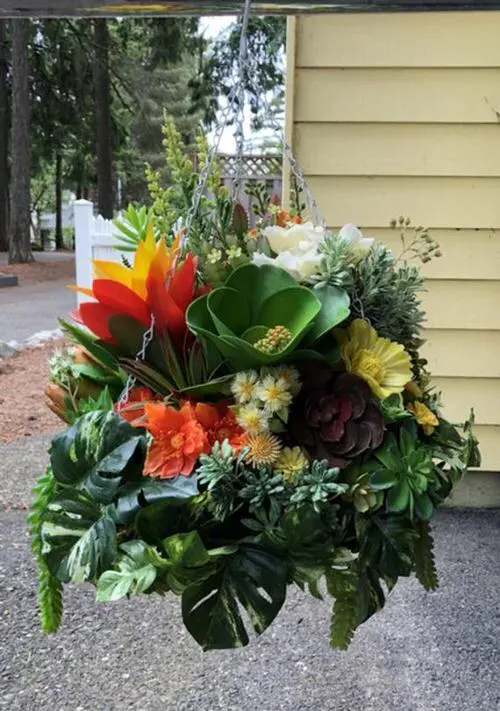
While they may not be as authentic as you want them to be, faux plants provide longer-lasting beauty to your space and are much easier to maintain.
Here, this hanging basket has been adorned with several faux succulent plants, creating a one-time décor solution for your space. If you’re using the décor outdoors, remember to pick weather-resistant fabrics suitable for such a space.
9. All Natural Trailing Look
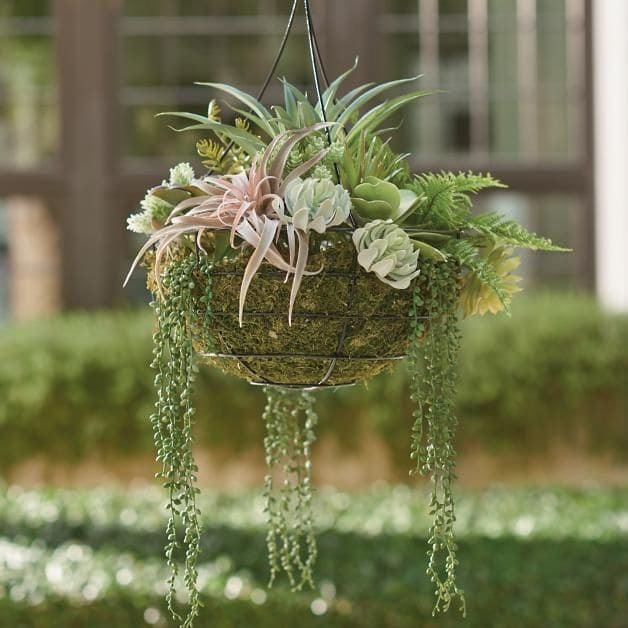
Creating contrast improves a planter’s visual interest, but even more interesting is adopting a consistent, all-natural look. Here, the natural green planter matches the succulents grown there.
The design makes for a well-draining planter, and the natural fibers and grass used to create the planters can also double as a nutrient source. Avoid using treated grass or hay for the planter, which could affect your plants’ health.
10. Try a Glass Terrarium
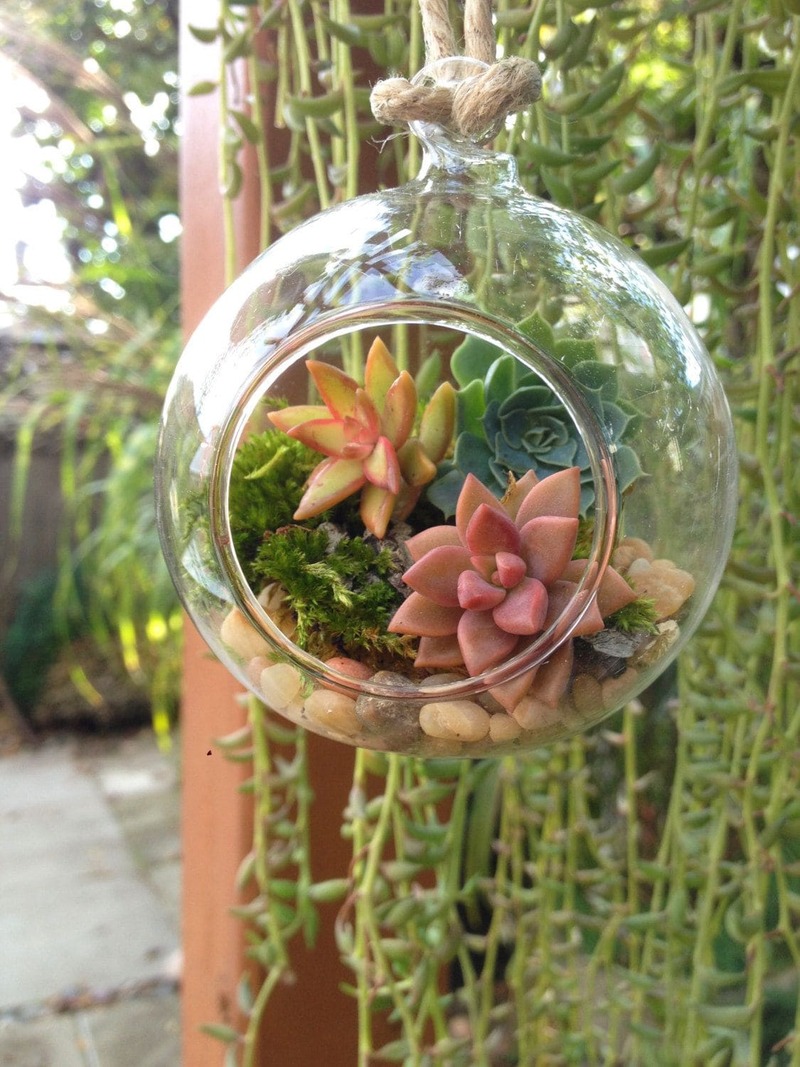
One thing that makes succulents easy to grow is that they’re very hardy plants, making them suitable for various surroundings, even rocky areas. The hardiness properties of these plants are clearly demonstrated in this hanging garden design, where a glass terrarium filled with small pebbles is used as a base.
The glass terrarium provides enough visibility to the plants inside, while the base’s unique design ensures good drainage despite the glass material used.
11. Grow Them In a Cage
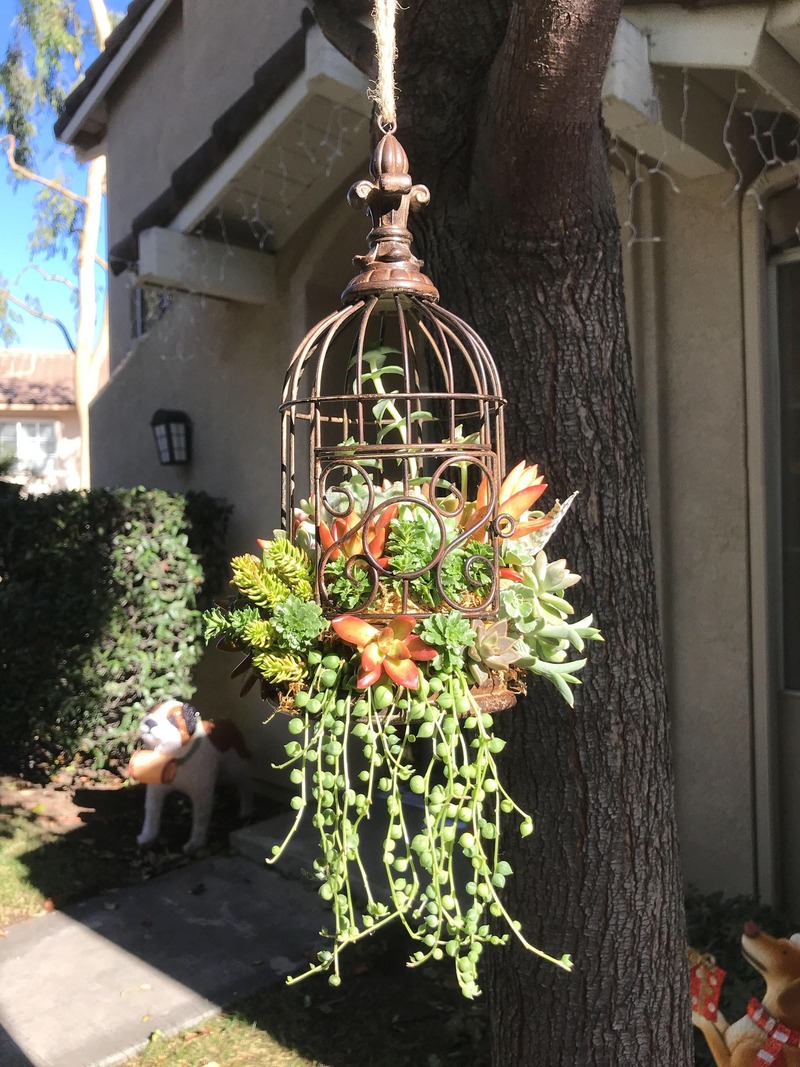
You can repurpose most items in your backyard to add flair and authenticity to your outdoor space, and a tiny cage is no exception.
Here, a cage has been partially filled with soil and repurposed into a planter. The cage’s rustic look adds an element of authenticity to the garden design.
12. Make it Whimsical
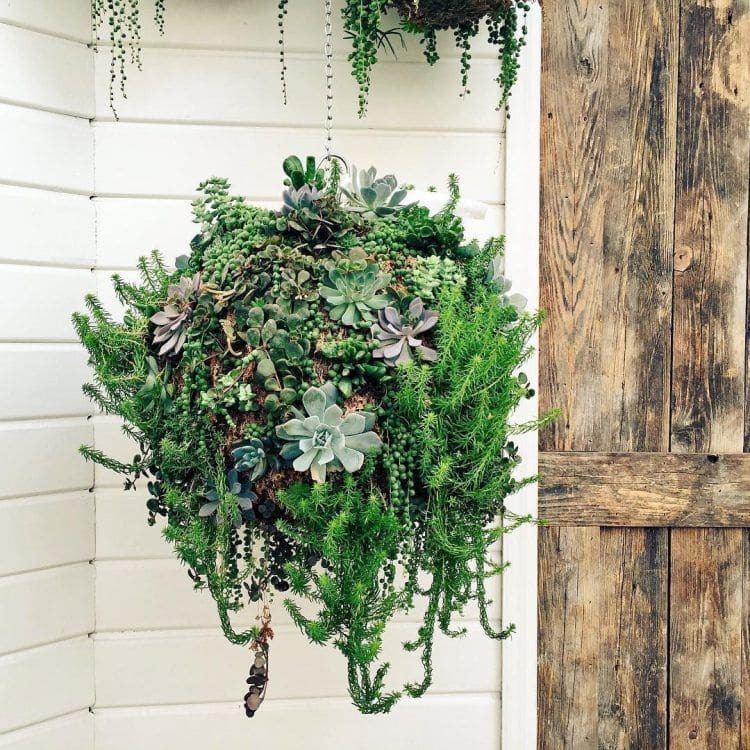
Gardening doesn’t always have to be in a meticulously designed planter. Sometimes, even the most unseemly designs can be effective in livening up a space and improving its curb appeal.
This planter follows a unique design where the exterior of the planter serves as the planting base, creating a “well-rounded” planter garden.
13. Use an Old Bird Cage
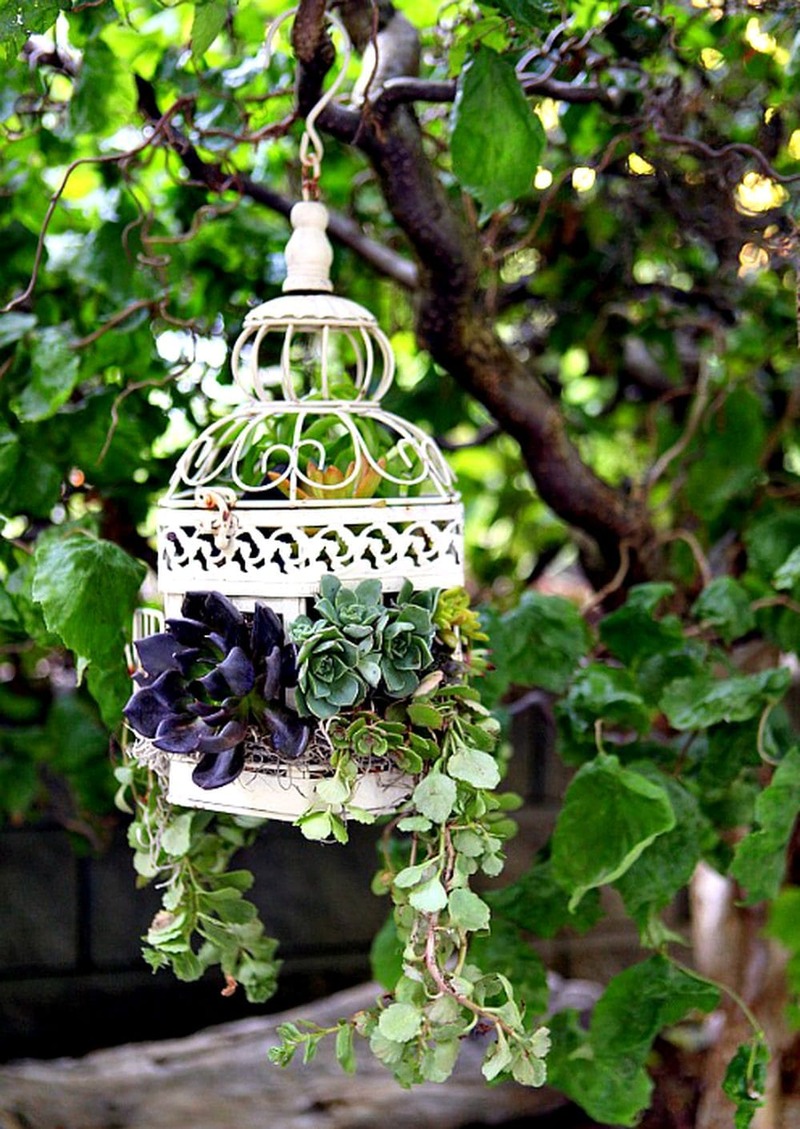
Old bird cages, which already have the hanging mechanism, can easily be repurposed into hanging planters. You only need to add a little potting soil, and your new planter will be ready to go.
If you’re using an open bird cage, you can redesign it by adding a small container to hold the soil. Don’t forget to add drainage holes to the container.
14. Go for a Circular Planter
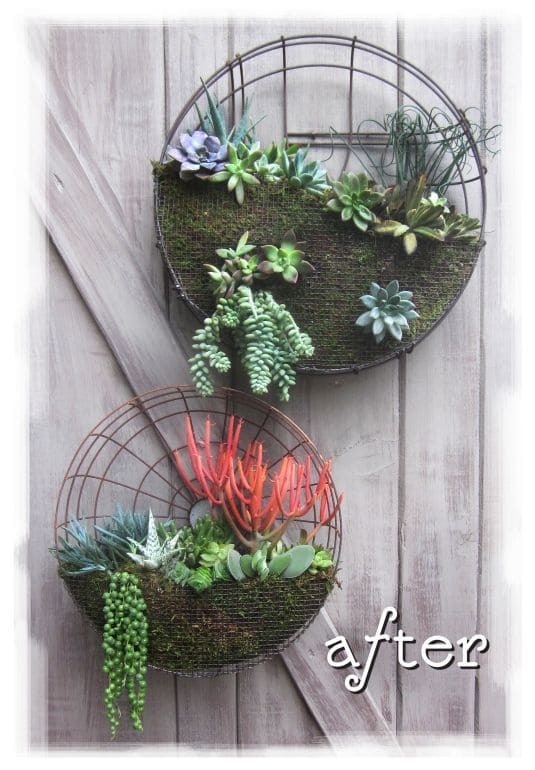
DIY projects make some of the best planters, and you don’t always have to spend money on supplies; you can simply create one from unused repurposing old items.
In this hanging garden design, circular DIY planters made from repurposed wires grow succulents. The material used to make the planters makes it easy to hang or suspend them in different places.
15. Create a Platform for Planters
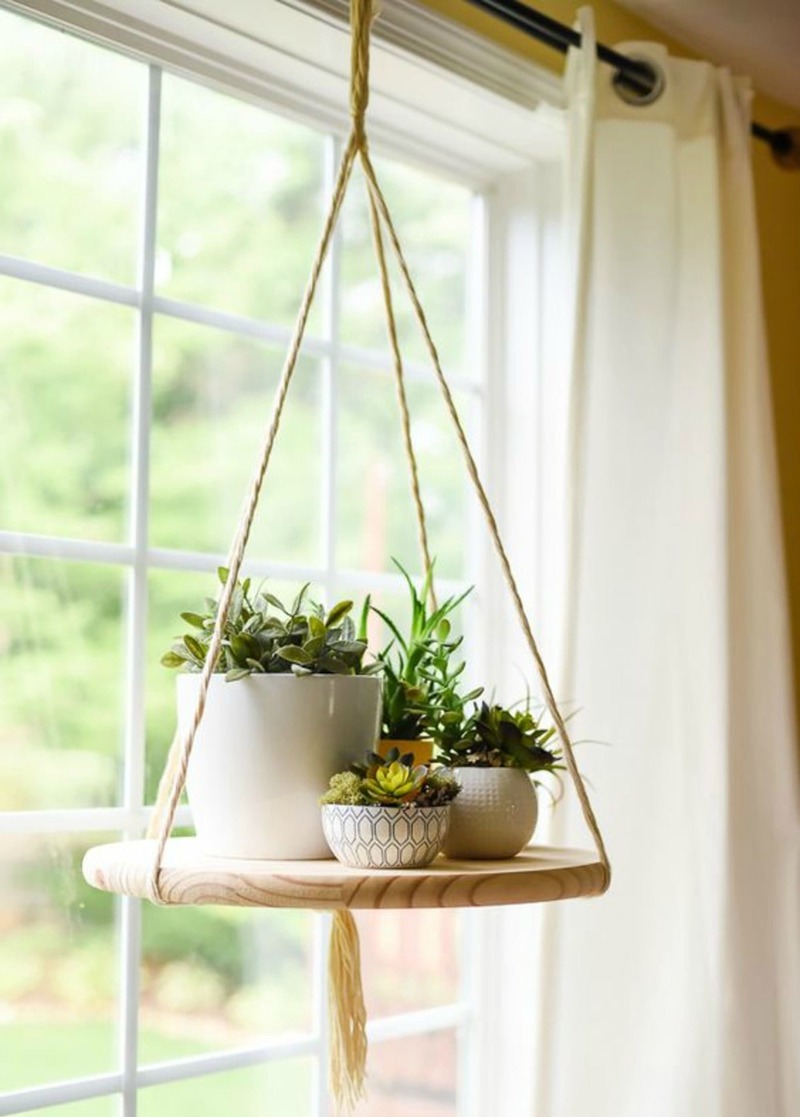
Sometimes, growing various succulents together may not be possible because they may have different growth requirements, such as watering, soil type, and fertilizing. Growing them in separate places, on the other hand, can make the plants less visually appealing.
This planter platform provides a solution to both of these challenges. Succulents in different planters are assembled together, providing them with planter-specific requirements and jointly contributing to the space’s aesthetic appeal.
16. Create a Succulent Garden Centerpiece
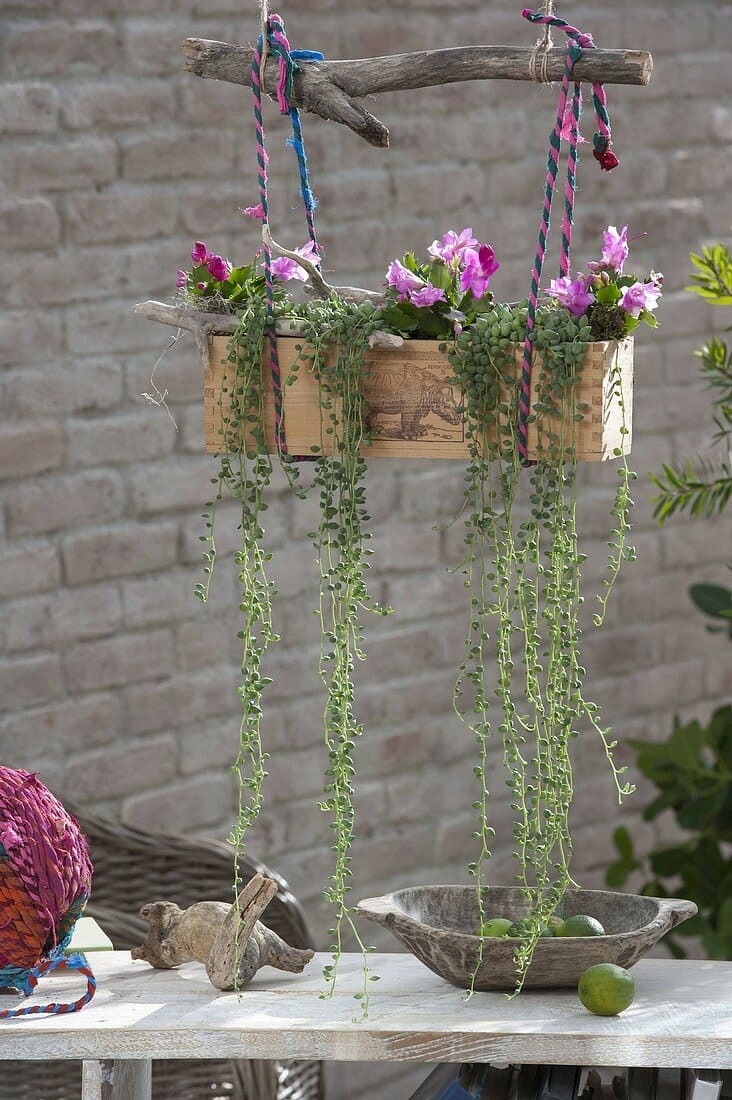
A centerpiece can transform a space’s outlook, and your outdoors is one area that could benefit from one.
This beautiful wooden planter brings succulents and flowers together to create a centerpiece that is brought to life. The engravings on the planter improve the design’s visual interest and contribute to its authenticity.
17. Repurpose an Old Garden Toolbox
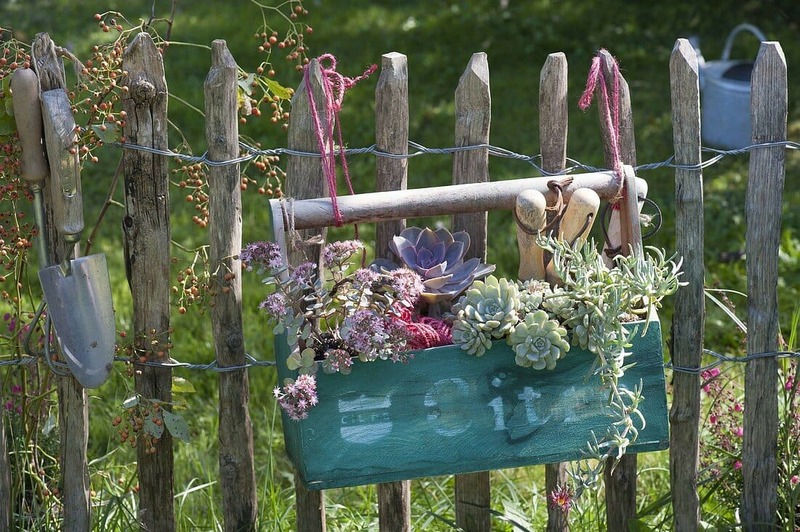
A toolbox is an invaluable addition to a backyard, ensuring your tools are in good shape to make the gardening process much more manageable. However, once an old toolbox becomes absolute, you don’t have to do away with it.
This unique succulent planter has been made from an old, repainted toolbox. The gardening tools added next to the planter are functional and contribute to the design’s theme.
18. Make a Jute Planter
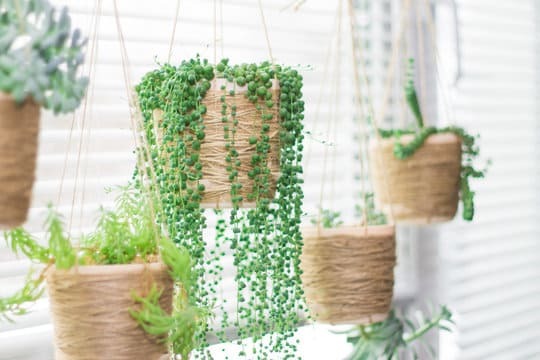
Gardens always look better when natural materials and fibers are used, contributing to the process’s naturalistic vibe. Here, natural jute fiber is used to create the planters to grow these String of Pearls plants.
To create this hanging garden design, you can either wrap containers in jute or make the entire planter from the material (likely to be structurally weak compared to wrapping containers).
19. Hanging Vertical Succulent Garden

Vertical planters are one of the most unique additions to your garden. They increase a space’s visual interest and are also really effective, especially when growing plants that need good drainage, such as succulents.
This artistic design uses three vertical planters to create an attractive hanging garden that resembles floating picture frames.
20. Succulent Wire Bowl

One thing that makes succulents easy to grow is that they’re mainly used as ground covers, so they can thrive even when not grown on deep soil. This makes it possible to use creative planters such as this wire bowl.
You can partially fill the bowl with small stones, some perlite, and moss, and you’ll be ready to grow your succulents in no time. The rustic look of the planter fits well with the outdoor surroundings.
21. Try a Woven Wooden Planter
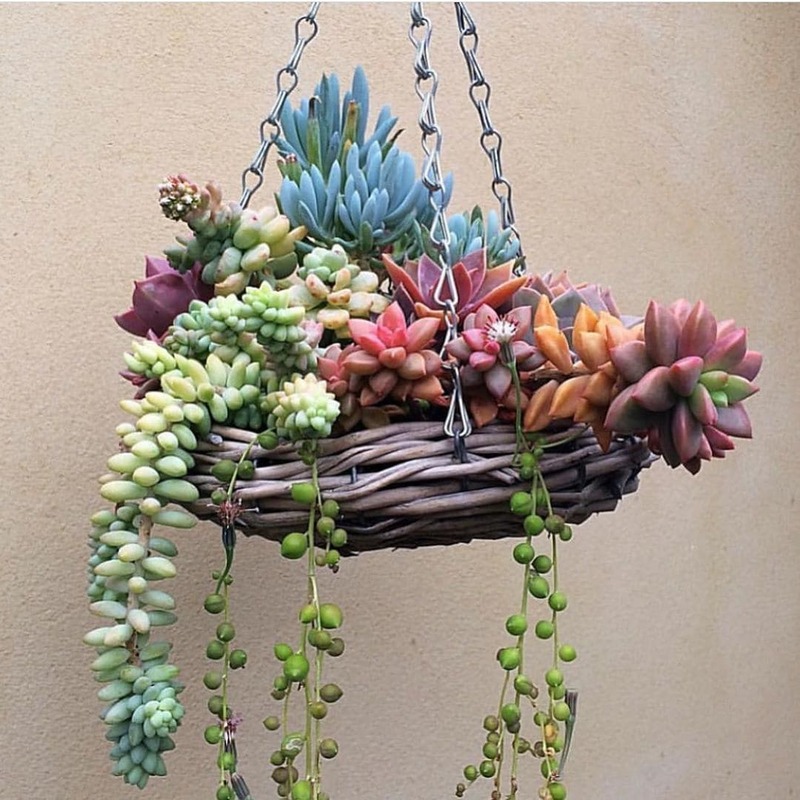
Personalizing your hanging garden can be challenging since it always seems that all the exciting designs have been explored. Weaving your planter could be the best solution to this conundrum.
It’s cost-effective, and you can also personalize your design with carvings you relate to. Not to mention, you can create planters of the size you desire. Here, a woven wooden planter made of sticks has been used to create the succulent garden.
22. Tiered Metal Pipe Garden
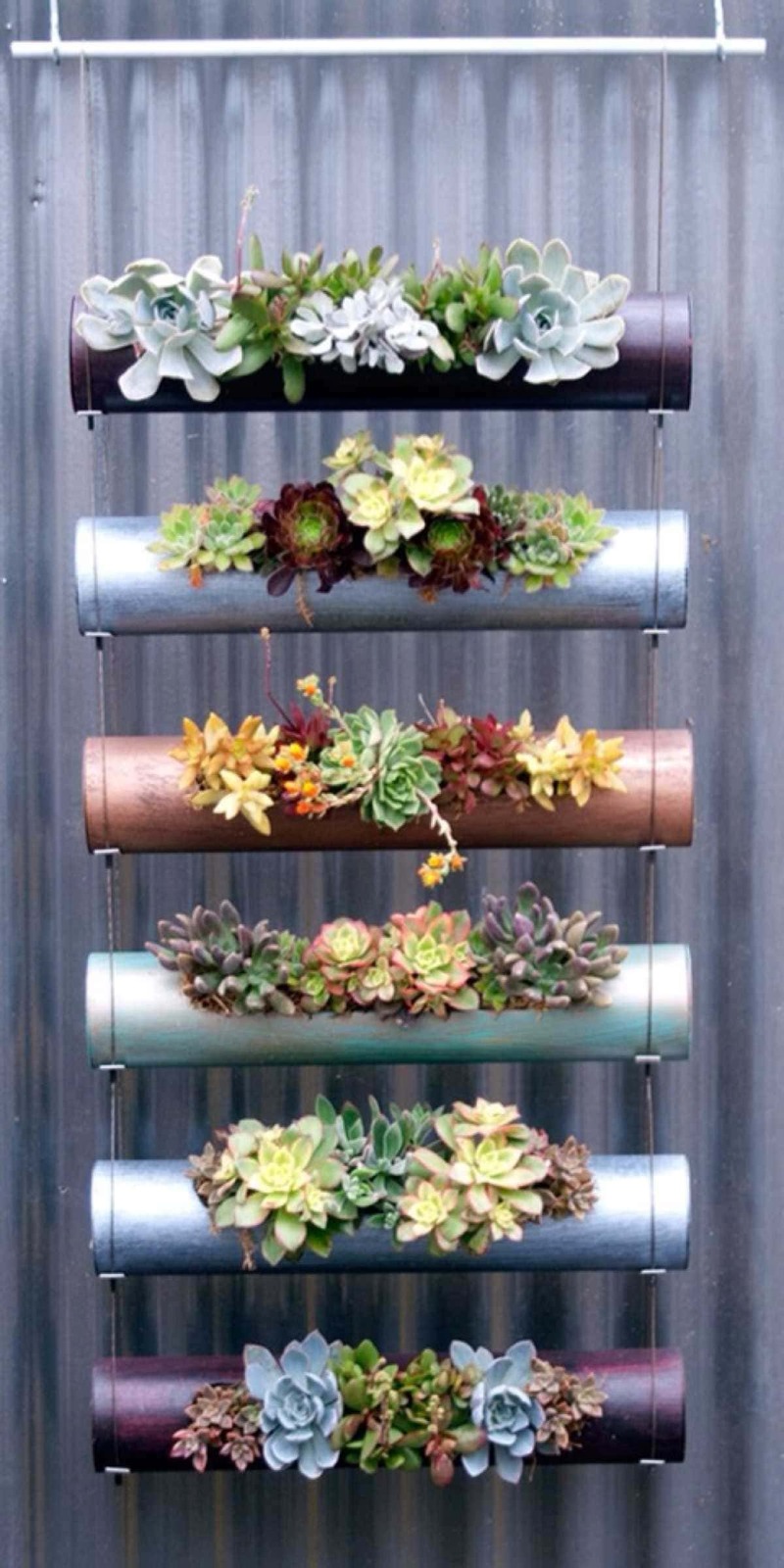
Another way to create a beautiful DIY garden is using broken pipes. While they may seem of no use, large broken pipes can be used to create a hanging succulent garden. Simply cut the pipes into pieces of about 2 feet and cover both sides of the pipe to form a cylinder.
Next, curve the pipe on one side, make small drainage holes on the other side, and grow your succulents. To add an extra dash of style, paint the pipes to match your space’s theme.
23. Maximize the Space
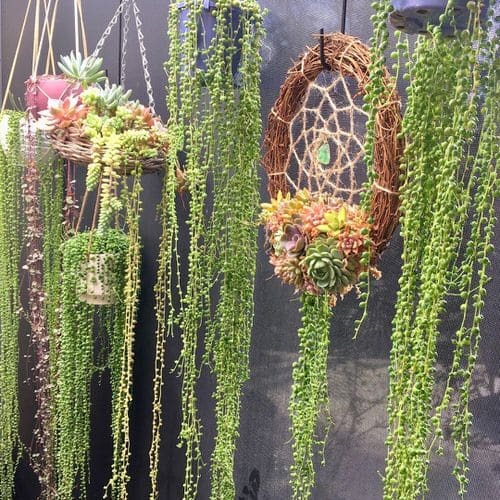
Being ground covers, one of the properties of succulents is vining. Varieties such as string of pearls have a fast growth rate and will vine with no time. Other than opting for trellises to support these vines, you can create a succulent “waterfall.”
In this design, several planters were used to grow several vining succulents. The free-falling vines liven up the space and bring an element of uniqueness to the garden.
24. Repurpose a Wooden Crate
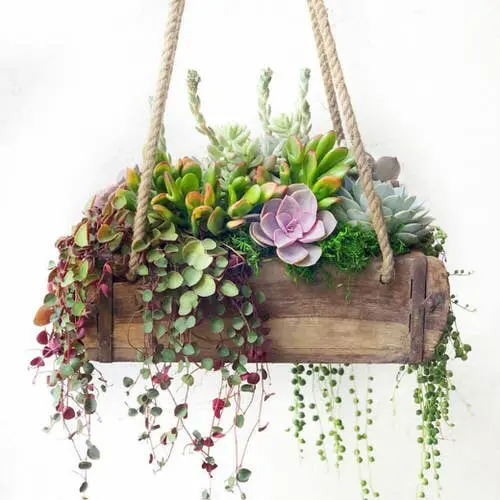
One of my favorite designs is the raised garden, which you can easily make using a wooden crate or frame. The same concept can be applied to create a hanging garden.
Simply fill an old wooden crate with potting soil, find an ideal place to hang it, and voila! You have yourself a hanging succulent garden.
25. Try Colorful Succulents
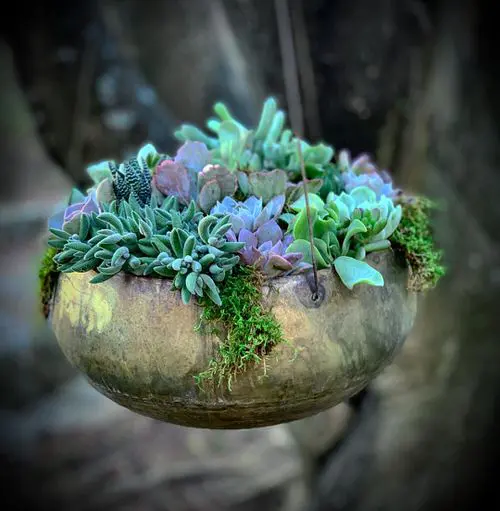
Decorating with succulents is much easier, as they come in pink, red, purple, and various shades of green.
Here, a wooden bowl has grown several colorful succulents, adding visual interest to the space and perfectly contrasting the planter and plants.
26. Use an Old Picnic Basket
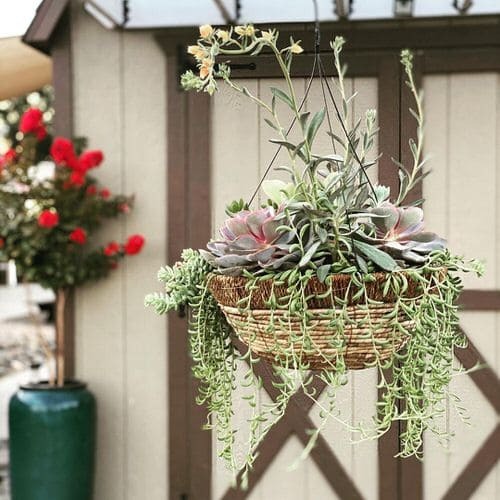
The number of items you can repurpose for a hanging succulent garden will never run out. If you can’t acquire any of the above-mentioned items, you can try an old picnic basket.
You only need to add potting soil to an old picnic basket, find a way to hang it, and start growing your succulents. Since picnic baskets are already porous, you won’t need to add drainage holes.
27. Succulent Jute Bowl
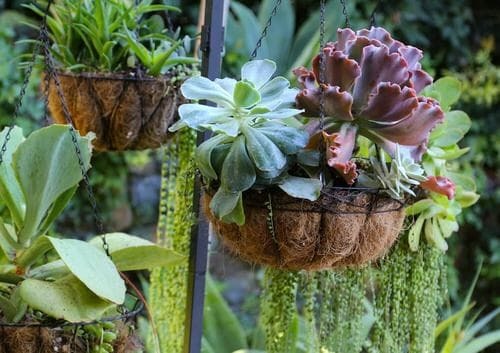
If you want to add a rustic farmhouse look to your space, this design will be ideal. Here, the planter is made from a wire frame with jute added to it to complete the design.
This makes for a well-draining and well-aerated planter. The planter’s rustic look fits well in a farmhouse design.
28. Go for Variety
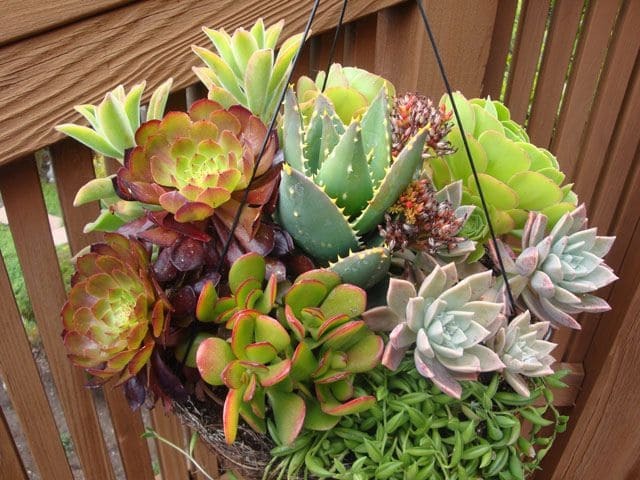
With so many options available, it can be hard to decide what succulent to grow, so opting for variety is always a good idea.
Since most of these plants have the exact plant care requirements, you can grow several in one planter. This hanging planter follows this concept with several succulents, including the highly versatile aloe plant.

